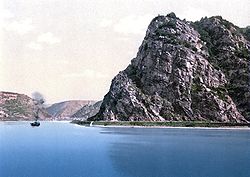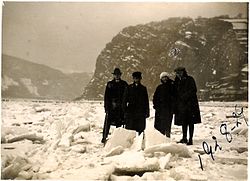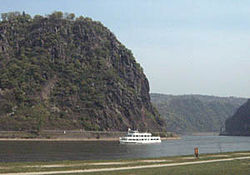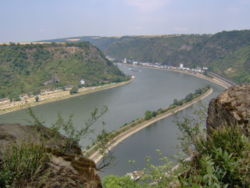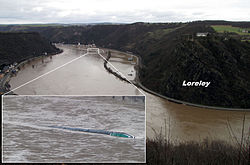- Lorelei
-
The Lorelei (also spelled Loreley) (German pronunciation: [loːʁəˈlaɪ]) is a rock on the eastern bank of the Rhine near St. Goarshausen, Germany, which soars some 120 metres above the waterline. It marks the narrowest part of the river between Switzerland and the North Sea. A very strong current and rocks below the waterline have caused many boat accidents there. Since 1395, the vineyards of the Counts of Katzenelnbogen have been located here.
Contents
Etymology
The name comes from the old German words "lureln" (Rhine dialect for "murmuring") and the Celtic term "ley" (rock). The translation of the name would therefore be: "murmur rock" or "murmuring rock". The heavy currents, and a small waterfall in the area (still visible in the early 19th century) created a murmuring sound, and this combined with the special echo the rock produces which acted as a sort of amplifier, giving the rock its name.[1] The murmuring is hard to hear today owing to the urbanization of the area. Other theories attribute the name to the many accidents, by combining the German verb "lauern" (to lurk, lie in wait) with the same "ley" ending, with the translation "lurking rock".
Original folklore and the creation of the modern myth
The rock and the murmur it creates have inspired various tales. An old legend envisioned dwarves living in caves in the rock.
In 1801 German author Clemens Brentano composed his ballad Zu Bacharach am Rheine as part of a fragmentary continuation of his novel Godwi oder Das steinerne Bild der Mutter. It first told the story of an enchanting female associated with the rock. In the poem, the beautiful Lore Lay, betrayed by her sweetheart, is accused of bewitching men and causing their death. Rather than sentence her to death, the bishop consigns her to a nunnery. On the way thereto, accompanied by three knights, she comes to the Lorelei rock. She asks permission to climb it and view the Rhine once again. She does so and falls to her death; the rock still retained an echo of her name afterwards. Brentano had taken inspiration from Ovid and the Echo myth.
In 1824 Heinrich Heine seized on and adapted Brentano's theme in one of his most famous poems, Die Lore-Ley. It describes the titular female as a sort of siren who, sitting on the cliff above the Rhine and combing her golden hair, unwittingly distracted shipmen with her beauty and song, causing them to crash on the rocks. In 1837 Heine's lyrics were set to music by Friedrich Silcher in a song that became well known in German-speaking lands. A setting by Franz Liszt was also favored, and over a score of other musicians have set the poem to music.[2]
The Loreley character, although originally imagined by Brentano, passed into German popular culture in the form described in the Heine-Silcher song and is commonly but mistakenly believed to have originated in an old folk tale. The French writer Guillaume Apollinaire took up the theme again in his poem "La Loreley".
Accident
A barge carrying 2,400 tonnes of sulphuric acid capsized on January 13, 2011 near the town of St. Goarshausen, home to the Lorelei rock, which marks the narrowest part of the Rhine, blocking traffic on one of Europe's busiest waterways amid a frantic search for two crew members.[3]
References in works of art
Works about, or referencing, the Lorelei:
- Kurt Vonnegut, Jr.'s "Der Arme Dolmetscher" ("The Poor Interpreter") focuses on a U.S. soldier stationed along the Siegfried Line in 1944, overheard repeating a portion of Heine's poem he learned in school. This is enough for his Executive Officer and Colonel to make him the battalion interpreter. The story first appeared in The Atlantic Monthly in July 1955, and reprinted in the 1999 collection Bagombo Snuff Box. [4]
- German composer Felix Mendelssohn began an opera in the mid-1800s based on the legend of the Lorelei Rhine Maidens for Swedish soprano Jenny Lind, however, he died before he had the chance to finish it.
- In Eichendorff's poem "Waldesgespräch," a rider meets a beautiful young woman in the forest who turns out to be "the witch Lorelei." She tells him that he will never leave the forest.
- George and Ira Gershwin wrote the song "Lorelei" for their musical Pardon My English (1933).
- Alfredo Catalani wrote an opera about the tale, Loreley.
- William Vincent Wallace wrote an opera too, Lurline.
- The rock bands Tom Tom Club, Styx, Cocteau Twins, Fleet Foxes, The Pogues, Scorpions, The Explorers, Wishbone Ash, Comeback Kid, Blackmore's Night and Theatre of Tragedy all wrote songs titled "Lorelei". There are also other songs about Lorelei from worldwide sources such as folk singer Luka Bloom.
- Roxy Music's 1973 album For Your Pleasure features a track called "Editions of You" in which the entire fourth verse is a reference to the Lorelei legend.
- Japanese rock band L'Arc-en-Ciel released a song called "Loreley" on their 1998 album, HEART.
- Sylvia Plath wrote a poem titled "Lorelei" (published in 1960 with The Colossus and Collected Poems), which many believe draws inspiration from the German legends, perhaps because her father was German.
- Eagle Eye Cherry tells his own version of the myth of Lorelei in his song "When Mermaids Cry".
- The name of Lorelei appears in multiple virtual games, including Tales of the Abyss (game for PlayStation 2) as a god who foresaw the future and wrote it in fonic stones, Dead or Alive 3 as a Stage the fighters do battle on and is the name of the song "Die Lorelei" in the soundtrack for the visual novel Fate/Stay night. It also appears as the name of the song 'Loreley' in the soundtrack for the visual novel Umineko no Naku Koro ni Chiru. Lorelei also appears as a female character in Suikoden I, Suikoden II and Suikoden V
- South Korean rock band The TRAX's song "Oh! My Goddess" mentions a "dazzling Lorelei" in the lyrics, when referring to the loved woman.
- Mark Twain references the Lorelei in A Tramp Abroad
- Paul McCartney sings "someone's on a mission to the lonely Lorelei" in his 1998 single Beautiful Night, which can be found on the 1997 Flaming Pie album.
- The Scorpions released an album in 2010 called Sting In The Tail containing a song called "Lorelei".
- The band Blackmore's Night has a song called "Loreley" on their album "Ghost of a Rose"
- In the symphony No.14 at the third movement by Dmitri Shostakovich
- The band Mercury Rev released an album in 2005 called "The Secret Migration" with a track called "Black Forest (Lorelei)"
- The band Theatre of Tragedy released an album in 1998 called "Aegis" with a track called "Lorelei"
- In The Spirit, a siren called Lorelei appears to the titular character encouraging him to give up and die. She also appears in The Spirit (film), whenever The Spirit is sleeping or close to death.
- Author Cornelia Funke references a species of siren-like creatures called the Lorelei in Reckless (2010 novel).
- In "Gentlemen Prefer Blondes", Marilyn Monroe plays the character Lorelei Lee.
- Japanese metal band DELUHI released a song called "Lorelei" on their 2009 single, Two Hurt FOOL'S MATE EDITION. It was re-mastered for the Vandalism album, 2011.
- Fabulous large canvas oil painting "Cursing of Lorelei by the Monks" by famous Estonian painter Johann Köler, hanging in Kumu (museum) in Tallinn.
- Dschinghis Khan (Genghis Khan) and their song "Lorely"
- Toad the Wet Sprocket references the call of the Lorelei in their song "All Right"
- The US Television show 12 O Clock high had a B-17 named Lorelei in the episode 'The Lorelei'.
- An allusion is made to one of the principal characters in James Joyce's magnum opus Finnegans Wake twice, where the character "ALP" is compared to a "siren of the Rhine".
- The Lorelei, and the myth of the Lorelei, were the premise used by author Patricia C. Wrede in a short story from her anthology, "Tales of Enchantment".
- The Lorelei was referenced in a song written for the 1957 movie "The Enemy Below".
- There are 3 characters called Lorelai (Grandmother, Mother and Daughter) in the TV series Gilmore Girls.
Notes
- ^ Loreley - Ein Beitrag zur Namendeutung. Accessed June 16, 2006.
- ^
 "Lorelei". Encyclopædia Britannica (11th ed.). 1911.
"Lorelei". Encyclopædia Britannica (11th ed.). 1911. - ^ Mara, Darren; Illmer, Andreas (January 13, 2011). "Tanker carrying acid capsizes in Germany's Rhine River". Deutsche Welle. http://www.dw-world.de/dw/article/0,,14764590,00.html.
- ^ Vonnegut, Kurt (July 1955). "Der Arme Dolmetscher". The Atlantic. Archived from the original on 2011-10-24. http://www.webcitation.org/62g2d8zT0. Retrieved 2011-10-24.
External links
- The Loreley, a vineyard of the Counts of Katzenelnbogen and their first Riesling of the World
- Lorelei Info Information all about the Lorelei
- [1] Heine poem with English translation
- Lorelei Song mp3
- Article about the Middle Rhine Valley with nice photo gallery (German)
- Translation of the German Saga, Lorelei, from Ludwig Bechstein's Saga Book
 Texts on Wikisource:
Texts on Wikisource:
- Heinrich Heine. "Lore-Lei". Littell's Living Age 141 (1822).
- "Lorelei". Encyclopædia Britannica (11th ed.). 1911.
- "Lorelei". Encyclopedia Americana. 1920.
Categories:- Rock formations in Germany
- Rheinsteig
- Water spirits
- German folklore
- Medieval legends
- Heinrich Heine
Wikimedia Foundation. 2010.


